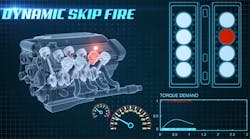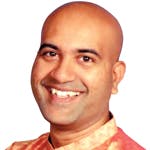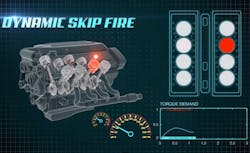Q&A: The Inside Scoop on Tula’s Automotive Fuel-Efficiency System
This file type includes high resolution graphics and schematics when applicable.
Dynamic Skip Fire (DSF) system (see the figure) is designed to improve automotive fuel efficiency. I spoke with Ram Subramanian, Technical Marketing Manager at Tula Technology, about DSF and the challenges they encountered when creating the system.
Wong: How did Tula Technology get started, and what’s your vision for the company?
Subramanian: Tula Technology was founded in 2008 by Dr. Adya Tripathi, a visionary who theorized that digital-signal-processing techniques in the audio field could be used to control an automotive engine. When the technology was proposed, experts in the field thought there would be too much noise and vibration for it to be useful. But the team at Tula proved them wrong by creating a demonstration vehicle that improves fuel efficiency of gasoline engines by 15% without sacrificing ride quality or increasing vehicular emissions.
We are working with many global automotive OEMs to bring the technology into production. Our vision for the company is to replace expensive and rigid mechanical automotive hardware with flexible software solutions for a safer, cleaner, greener, and practical automobile for the future.
Wong: Tell us about Tula’s Dynamic Skip Fire (DSF) system. What differentiates it from other technologies and approaches to improving fuel efficiency?
Subramanian: Current technology uses fixed cylinder deactivation, where only half of the cylinders are deactivated at any given time. Tula’s Dynamic Skip Fire (DSF) technology is the industry’s first individual cylinder deactivation system that successfully manages vehicle noise, vibration, and harshness (NVH) while providing as much as 15% fuel-efficiency benefits compared to a vehicle without cylinder deactivation.
DSF integrates advanced signal processing with sophisticated powertrain controls to create the ultimate variable-displacement engine, delivering optimal fuel efficiency at the lowest cost. It is the only high-value, low-cost solution in the market for fuel efficiency of gasoline engines. DSF complements other fuel-saving technologies, such as direct injection, turbocharging, start/stop, mild and full hybrids, low-rolling resistance tires, and low-friction lubricants. It can also be applied to all cylinder configurations and displacements.
Wong: From a technical perspective, how was the DSF system designed and developed?
Subramanian: DSF technology has roots in advanced digital signal processing pioneered in the audio-amplification field. Dr. Tripathi realized that a car engine could also be controlled by such a technique, but fortunately he did not know enough about cars to dismiss the idea as unworkable, as most automotive experts thought.
The dynamic nature of individual cylinder skip fire was perceived to cause a mechanical imbalance, resulting in excessive NVH. In fact, the opposite is true, as by dynamically changing the frequency of the firing pulses, you can avoid natural resonance frequencies in the engine that leads to undesirable excitations. The Tula team reverse-engineered a complete engine-control system of a production vehicle, implemented and fine-tuned DSF, and demonstrated the fuel-efficiency gains with production-level NVH. DSF and related controls technologies now make up over 20 issued patents at Tula, with more than 60 patents pending globally.
Wong: Were there any major challenges? If so, how did you overcome them?
Subramanian: There were many major challenges on the road to demonstrating and making DSF a product. One of the main challenges was dealing with a closed control system of a production vehicle. The expertise and experience in the Tula team, with the support of appropriate tools, helped with the reverse-engineering of the controls schemes necessary to implement DSF.
At every step of creating a demonstration vehicle, the Tula team had to devise new algorithms and workarounds to integrate DSF into the existing controls architecture of the production vehicle. Apart from that, the team also had to control and command other parts of the vehicle, such as the transmission, to fine-tune the drivability. Safety and security, as well as emissions control, also had to be taken care of, in essence without any help from the production OEM.
Third-party tuning tools, diagnostics software tools, and the sheer determination of the team at Tula helped overcome these problems. A demonstration vehicle was vital to change the minds of automotive experts who had the preconceived notion that such a control scheme was not possible in any engine!
Wong: What tools, technology or best practices were essential to successfully developing the DSF system?
Subramanian: We have multiple software development environments with various tools and platforms. Perforce Helix is at the center, managing all of our source code and environment configurations. We have an Agile development model that enables quick iterations of develop, test, improve, and retest, and an innovative automated test environment called webcarlab, which we can access remotely and automatically for 24/7 testing. We run regression tests on all our releases to make sure they are always tested to the fullest extent.
Tula’s DSF technology is built upon decades of combined engineering expertise in digital signal processing, NVH reduction, powertrain-control integration, engine analysis and simulation, embedded-systems hardware and software, and engine onboard diagnostics. Our culture of inclusion, respect, and relentless forward progress unifies the varied group of 44 employees at Tula.
Wong: When will the DSF system be available and implemented in the market?
Subramanian: Product and technology announcements are best communicated by the OEMs, but DSF technology is ready for production. It’s gone through all appropriate testing and validation, and is ready to be integrated as a significant fuel-efficiency option. We recently completed a round of funding and are working diligently with various OEMs and suppliers to bring the technology to market. We expect more specifics on production in the next year or so. GM Ventures and Delphi are investors in the company, along with other venture capital investors.
Wong: Where do you see the DSF technology going in the next few years, and how do you expect it to impact the industry?
Subramanian: We are constantly innovating in the DSF, software, and controls space. We will see more fuel efficiency from more advanced technologies. Tula’s DSF technology saves over three tons of carbon dioxide over the life of a vehicle. We expect DSF to be common in new vehicles a decade from now.




